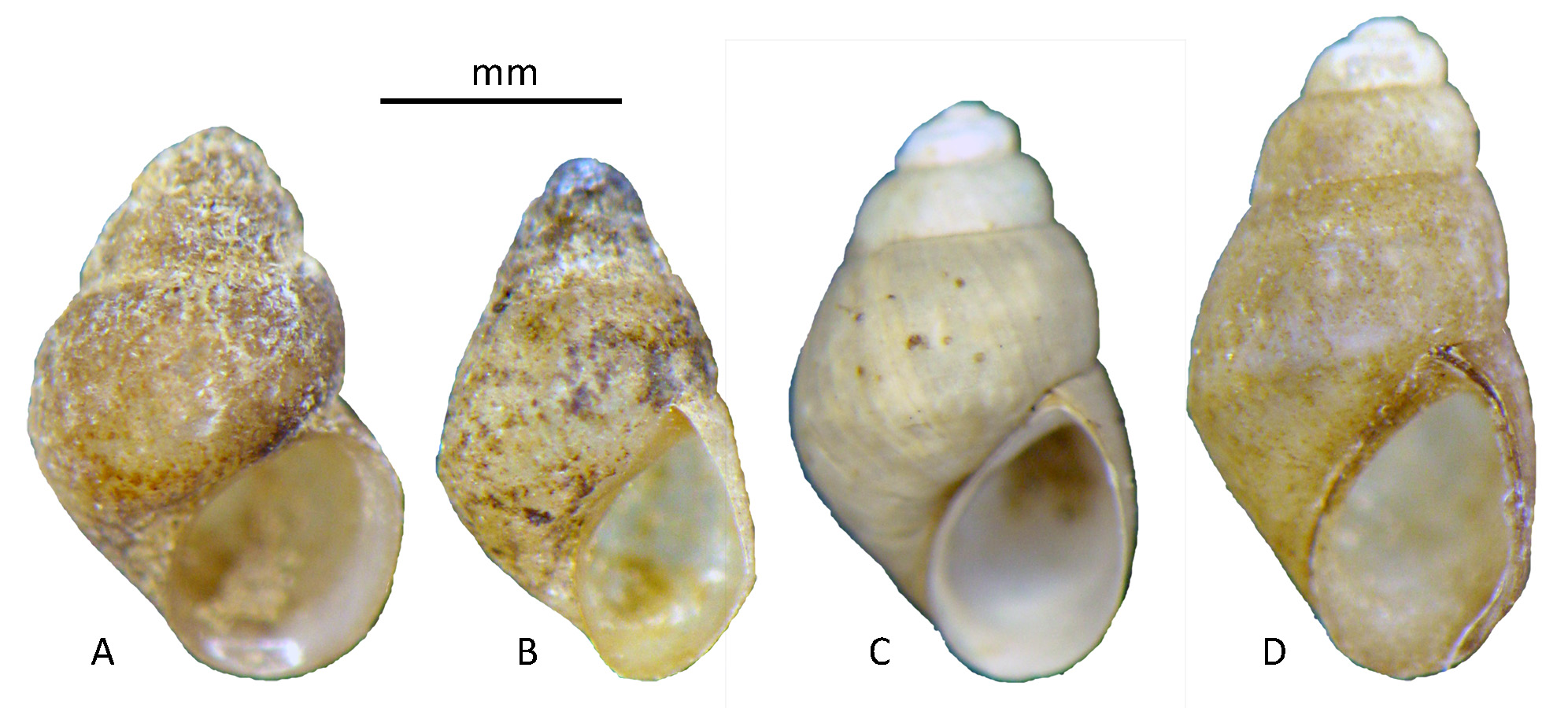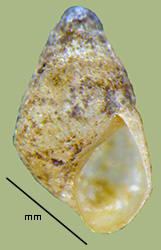> Habitat & Distribution
Thompson described Marstonia angulobasis as endemic to the Paint Rock River, a direct tributary of the main Tennessee R. in North Alabama. Our observations suggest both that the population inhabiting the Paint Rock is a shell morphological variant of Marstonia pachyta (ss), and that the actual range of M. pachyta angulobasis extends in very patchy fashion through scattered tributaries of the Cumberland River – the Red, the Stones, and Caney Fork A single enigmatic shell found by our colleague R. E. Evans on the banks of Elkhorn Creek north of Frankfort, KY, may also be M. pachyta angulobasis.
At its Limestone Creek type locality, Thompson reported that “Snails were found only on aquatic bryophytes growing on limestone in the faster current.” That was generally our impression as well. All of the rivers from which M. pachyta angulobasis populations have been documented are rich and hard.
FWGNA incidence rank for both subspecies considered together I-3*, non-apparently rare. Marstonia pachyta was listed as “endangered” by the US Fish & Wildlife service on 02-25-2000.
> Ecology & Life History
The cryptic habitat of Marstonia pachyta angulobasis seems to suggest a diet that does not ordinarily include algae, but rather very fine organic matter or bacteria. One might speculate that temperature, light, current, and other environmental factors in such a habitat would be fairly constant, suggesting constant (perhaps low) levels of reproduction year round. Hydrobiids are typically dioecious, the males being characterized by a penis that arises from the neck. Eggs are generally laid singly, attached in a spare capsule to a solid substrate.
> Taxonomy & Systematics
Marstonia pachyta angulobasis is another entry in the rather long list of small-bodied, wide-ranging, and obscure hydrobiids of eastern North America bearing narrow shells and (often) a carinate body whorl. Thompson’s original (2005) description included figures of the shell, operculum, and reproductive anatomy.
The taxonomic history of the genus Marstonia is complicated. Thompson raised Baker’s (1926) subgenus Marstonia to the full genus level in his monograph of 1977, placing underneath it three previously-described species and five species he newly described, including M. pachyta (ss). This eight-species model was transmitted by Burch (1989).
Hershler and Thompson (1987) synonymized Marstonia under Pyrgulopsis (Call & Pilsbry 1886) on the basis of similarities in penial morphology. But after review of female reproductive anatomy, Thompson and Hershler (2002) resurrected Marstonia to generic status and allocated back into it M. pachyta, as well as (by that point) eleven other species from around the eastern USA. Female reproductive anatomy, specifically occurrence of a large extension of the albumen gland into the pallial roof, is a distinctly Marstonia characteristic (Hershler 1994, Hershler et al. 2003). Recent molecular-based phylogenetic analyses has also supported the distinction between Marstonia and Pyrgulopsis (Liu and Hershler 2005), as well as the retention of both genera in the Hydrobiidae sensu strictu (Wilke et al. 2013).
Our discovery of typical M. pachyta (ss) in the Flint River drainage 25 miles east of its Limestone/Piney type locality led to the recognition that populations inhabiting the Paint Rock River just another 10 miles beyond are best understood as a subspecies. See my essay of 3Nov22 from the link below for more.
>Maps and Supplementary Resources
- Marstonia distribution in the Tennessee/Cumberland (2022)
- Marstonia
pachyta angulobasis from the Paint Rock River
(A,B), Smith Fork of
the CUMB:Caney (C), and the West Fork Stones River (D).

>Essays
- Earlier versions of this website, online until August of 2016, adopted the large, broadly-inclusive concept of the Hydrobiidae (sl) following Kabat & Hershler (1993). More recently the FWGNA project has shifted to the Wilke et al. (2013) classification system, distinguishing a much smaller Hydrobiidae (ss) and elevating many hydrobioid taxa previously ranked as subfamilies to the full family level. For more details, see The Classification of the Hydrobioids.
- For background info on the group of Marstonia that Thompson characterized to as “small narrow hydrobiids that have in common a carinate body whorl,” see my essay of 4Oct22, The SNHTHICACBY Marstonia 5: scalariformis.
- See
my essay of 3Nov22, The SNHTHICACBY Marstonia 6: pachyta,
for a review
of the reasoning behind our suggestion that Thompson’s angulobasis be
lowered to the subspecific level. That
essay includes several nice figures illustrating variation in pachyta shell
morphology as well.
> References
Baker, F. C. (1926)
Nomenclatural notes on American fresh water Mollusca. Transactions of
the Wisconsin Academy of Sciences, Arts, and Letters 22:193-205.
Burch, J. B. (1989)
North American Freshwater Snails. Malacological Publications,
Hamburg, MI. 365 pp.
Call R. E. &
Pilsbry H. A. (1886) "On Pyrgulopsis, a new
genus of rissoid mollusk, with description of two new forms".
Proceeding Davenport Academy of Natural Sciences V.: 9-14.
Haggerty, TM and JT
Garner (2008) Distribution of the armored snail (Marstonia pachyta)
and slender Campeloma (Campeloma
decampi) in Limestone, Piney, and Round Island Creeks,
Alabama. Southeastern Naturalist 7(4) 729-736.
Hershler, R. (1994)
A review of the North American freshwater snail genus Pyrgulopsis
(Hydrobiidae). Smithsonian Contributions to Zoology 554: 1 -
115.
Hershler,R., Liu,H-P. and
Thompson,F.G. (2003)
Phylogenetic relationships of North American nymphophiline gastropods
based on mitochondrial DNA sequences. Zool. Scr. 32 (4),
357-366.
Hershler, R., and F.G.
Thompson (1987) North American Hydrobiidae
(Gastropoda: Rissoacea): redescription and systematic relationships of Tryonia Stimpson,
1865 and Pyrgulopsis
Call and Pilsbry, 1886. The Nautilus 101:25-32.
Kabat, A.R., and R.
Hershler (1993) The
prosobranch snail family Hydrobiidae (Gastropoda: Rissooidea): review
of classification and supraspecific taxa. Smithsonian Contributions to
Zoology 547:1-94.
Liu, H., and R. Hershler
(2005)
Molecular systematics and radiation of western North American
nympholine gastropods. Molecular Phylogenetics and Evolution
34:284-298.
Thompson, F.G. (1977)
The hydrobiid snail genus Marstonia.
Bulletin of the Florida State Museum 21(3):113-158.
Thompson, FG (2005)
Two new species of hydrobiid snails of the genus Marstonia from Alabama
and Georgia. The Veliger 47: 175 – 182.
Thompson, F. G. &
R. Hershler (2002) Two genera of North American
freshwater snails: Marstonia
Baker, 1926, resurrected to generic status, and Floridobia, new
genus (Prosobranchia: Hydrobiidae: Nymphophilinae). The
Veliger 45: 269 - 271.
Wilke T., Haase M.,
Hershler R., Liu H-P., Misof B., Ponder W. (2013)
Pushing short DNA fragments to the limit: Phylogenetic relationships of
“hydrobioid” gastropods (Caenogastropoda: Rissooidea). Molec.
Phyl. Evol. 66: 715 – 736.







